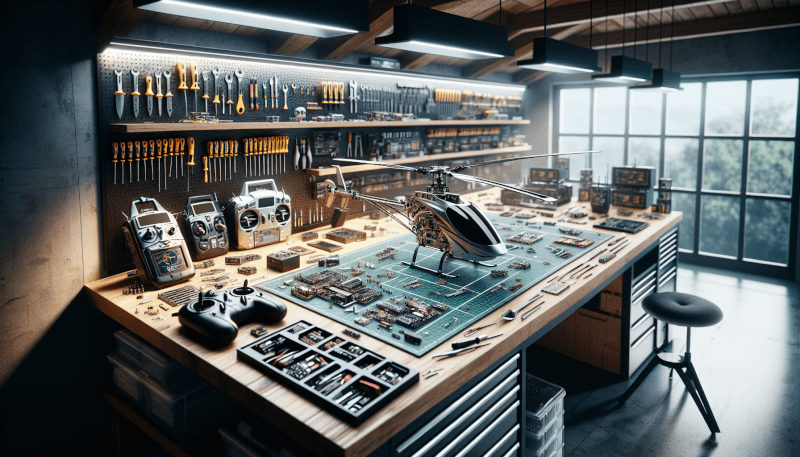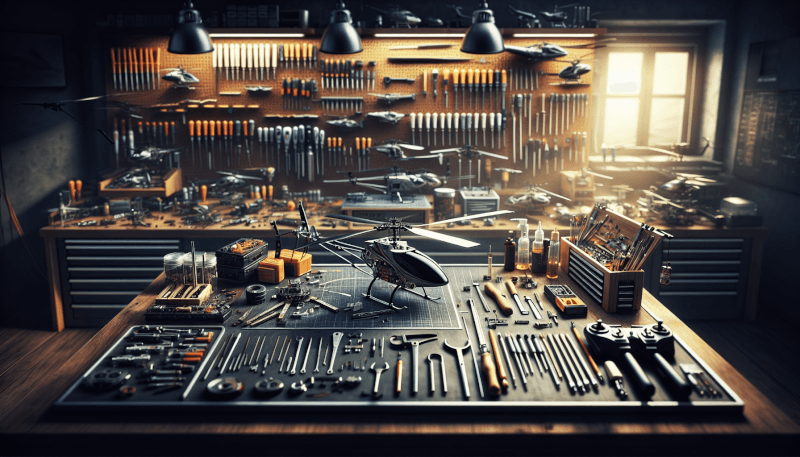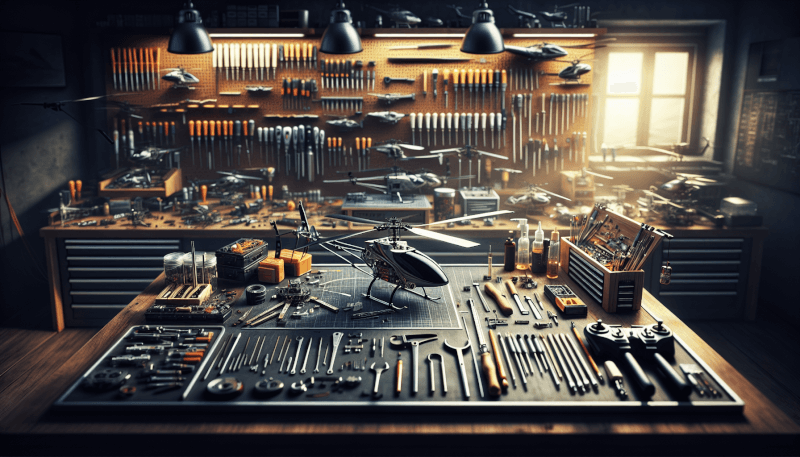Are you an aspiring RC helicopter enthusiast? If so, then you’ve come to the right place! In this comprehensive guide, we will walk you through the step-by-step process of building your very own RC heli workshop. From choosing the right location to setting up the essential tools and equipment, we’ve got you covered. Get ready to embark on an exciting journey as we help you create the perfect space to tinker, repair, and fly your beloved RC helicopters. So, let’s get started and turn your dreams into reality!

Setting Up Your Workshop
Choosing the Right Space
When setting up your RC helicopter workshop, it’s important to choose the right space that suits your needs. Look for an area that provides enough room to comfortably work on your helicopter, store your tools and equipment, and allows for easy movement. A dedicated room or garage is ideal, as it provides privacy and minimizes distractions. Ensure that the space has adequate lighting and ventilation to create a comfortable working environment.
Organizing Your Tools and Equipment
To efficiently build and maintain your RC helicopter, it’s crucial to have your tools and equipment well-organized. Invest in a toolbox or tool chest that can safely store and protect your tools from damage. Arrange your tools in a logical order, keeping frequently used ones within easy reach. Consider using pegboards or wall-mounted organizers to maximize space utilization and ensure quick access to your tools. Remember to label each tool’s designated spot to maintain a clutter-free and organized workspace.
Creating a Workbench
A sturdy workbench is essential for any RC helicopter enthusiast. It provides a stable surface for assembling and working on your helicopter. When selecting or building a workbench, opt for one that is at a comfortable height for you to work on without straining your back. Ensure the workbench has a smooth and flat surface to minimize any unwanted movement or vibrations while working. Consider adding a vice grip and a magnifying glass to your workbench for intricate tasks.
Essential Tools and Equipment
Screwdrivers and Wrenches
Screwdrivers and wrenches are fundamental tools for any RC helicopter enthusiast. Invest in a set of high-quality, precision screwdrivers with various sizes and types of heads to cater to different screw types and sizes. A set of screwdrivers with magnetic heads can be particularly useful in preventing screws from getting lost during assembly. Additionally, having a set of wrenches in different sizes will allow you to tighten or loosen nuts and bolts securely.
Pliers and Cutters
Pliers and cutters are crucial for handling wires and cables, as well as cutting and stripping them during the assembly process. Needle-nose pliers are ideal for gripping small components and reaching tight spaces, while wire cutters with sharp blades ensure clean and precise cuts. Consider investing in a set of pliers that includes side cutters, long nose pliers, and wire strippers for maximum versatility.
Soldering Iron and Solder
Soldering is often required when connecting wires and electronics in an RC helicopter. Invest in a good quality soldering iron that provides precise temperature control and has interchangeable tips for different soldering tasks. A soldering iron stand with a sponge for cleaning the tip is also essential for safety and convenience. Choose lead-free solder with a rosin core for clean and reliable solder joints.
Multimeter
A multimeter is an indispensable tool for troubleshooting and diagnosing electrical issues in your RC helicopter. It allows you to measure voltage, current, resistance, and continuity, ensuring that your electrical connections are functioning properly. Invest in a digital multimeter that offers accurate readings and has various measurement capabilities to cover a wide range of electrical components.
Battery Charger
Proper battery charging is crucial for the performance and lifespan of your RC helicopter. Invest in a quality battery charger that is compatible with the batteries used in your helicopter. Look for a charger that offers features such as adjustable charging rates, individual cell monitoring, and automatic safety cutoffs to prevent overcharging and battery damage. Consider getting a charger that can handle multiple battery chemistries and sizes for versatility.
Selecting the Right Helicopter Kit
Understanding Different Types of Kits
When selecting a helicopter kit, it’s important to understand the different types available and choose one that aligns with your preferences and skills. There are three main types of helicopter kits: Ready-to-Fly (RTF), Bind-and-Fly (BNF), and Almost-Ready-to-Fly (ARF). RTF kits come fully assembled and are ready to fly out of the box, while BNF kits require you to bind them to a compatible transmitter before flight. ARF kits provide the helicopter’s main components, but require additional assembly.
Considering Skill Level
Consider your skill level when choosing a helicopter kit. Beginners may want to start with RTF or BNF kits, as they provide a complete package and minimize the initial learning curve. Intermediate and advanced builders may opt for ARF kits, as they allow for more customization and the satisfaction of building from scratch. Be realistic about your abilities and choose a kit that matches your current skill level, allowing room for growth and learning.
Researching Quality Brands
It’s essential to research and choose a reputable brand when selecting a helicopter kit. Look for brands that have a reputation for quality, reliability, and customer support. Reading reviews and seeking recommendations from experienced RC helicopter enthusiasts can provide valuable insights into the performance and durability of different brands. Consider visiting local hobby shops or attending RC heli events to see firsthand the helicopters and brands preferred by experts in the field.
Building Your Helicopter
Reading and Understanding Instruction Manuals
Before diving into the assembly process, carefully read and understand the instruction manual provided with your helicopter kit. The manual will guide you through each step of the building process, ensuring you assemble the helicopter correctly. Take the time to familiarize yourself with the parts and terminology used in the manual. If you come across any unclear instructions, consult online resources or reach out to the manufacturer’s customer support for clarification.
Preparing Parts and Components
Proper preparation of the parts and components is crucial for a smooth assembly process. Organize the parts according to the instruction manual and ensure they are clean and free from any debris or damage. Check for any missing or defective parts and contact the manufacturer if necessary. Take your time to inspect and prepare each component before proceeding to the assembly stage to avoid potential issues or setbacks during the building process.
Correctly Assembling the Frame
Assembling the frame is a critical step in building your RC helicopter. Follow the instruction manual carefully, ensuring that each component is securely fastened. Pay attention to the sequence of assembly and any specific alignment or adjustment requirements. Double-check that the frame is square and level to ensure stability and proper functioning of the helicopter. Take your time during this stage, as a well-built frame forms the foundation for the rest of the assembly.
Installing Motors and Electronics
Installing motors and electronics requires precision and attention to detail. Follow the instruction manual’s guidelines for motor installation and ensure proper alignment and balance. When connecting the electronics, double-check that the wires are correctly soldered, and connections are secure. Take extra care to protect sensitive components such as the flight controller or receiver from static electricity and physical damage during installation.
Wiring and Connecting Components
Wiring and connecting the various components of your RC helicopter can be a complex task. Pay close attention to the wiring diagrams provided in the instruction manual to ensure proper connections. Use cable ties or wire loom to organize and secure cables, preventing them from tangling or interfering with other components. Properly route and secure all wires to minimize the risk of damage during flight. Consider labeling each connection for easier troubleshooting and future modifications.

Testing and Adjusting
Performing Preliminary Checks
Before your maiden flight, it’s crucial to perform preliminary checks to ensure the safety and proper functioning of your RC helicopter. Double-check that all components are securely fastened and nothing is loose. Verify that the blades are balanced and rotating freely. Test the responsiveness of the controls and ensure that all servos and gyros are functioning correctly. Take the time to inspect the battery for any damage or swelling and ensure it is fully charged.
Adjusting and Balancing Blades
Blade adjustment and balance are crucial for smooth and stable flight. Use a blade balancer to check for any imbalance and adjust them accordingly. Balancing the main and tail rotor blades will enhance performance and stability, minimizing vibrations during flight. Follow the instructions provided with the blade balancer and make incremental adjustments until the blades are perfectly balanced.
Fine-tuning the Gyro and Servos
Fine-tuning the gyro and servos is essential for precise and responsive control of your RC helicopter. Access the gyro and servo settings through the flight controller or radio transmitter and make adjustments according to your flying preferences. Take the time to understand the different parameters and how they affect the helicopter’s behavior. Experiment with different settings and fine-tune them until you achieve the desired flight characteristics.
Performing Test Flights
Performing test flights is the final step before enjoying the full capabilities of your RC helicopter. Choose a safe and open area, away from people and obstacles, to conduct your test flights. Start with short and low-altitude flights to ensure stability and correct any minor issues that may arise. Gradually increase the flight duration and altitude, checking for any abnormal behavior or control issues. Observe how the helicopter responds to different maneuvers and adjust the settings accordingly for optimal performance.
Understanding RC Helicopter Maintenance
Cleaning and Lubricating
Proper cleaning and lubrication are essential for maintaining the performance and longevity of your RC helicopter. Use a soft brush or compressed air to remove dirt and debris from the frame, rotor blades, and electronics. Avoid using excessive force or abrasive materials that could damage delicate components. Lubricate moving parts such as bearings and gears with specialized lubricants designed for RC helicopters. Regular cleaning and lubrication will prevent premature wear and ensure smooth operation.
Inspecting and Replacing Parts
Regular inspection of your RC helicopter’s components is crucial to detect any signs of wear or damage. Check for loose screws, cracks, or bent parts that may compromise the helicopter’s structural integrity. Inspect the wiring and electronics for any signs of fraying or loose connections. Replace any damaged or worn-out parts immediately to prevent further damage or potential accidents. It’s also important to periodically check the battery’s condition and replace it if it shows signs of degradation.
Troubleshooting Common Issues
Even with proper maintenance, RC helicopters may encounter common issues such as loss of control or erratic behavior. Take a systematic approach when troubleshooting these issues, starting with the most basic and easily fixable factors, such as low battery or loose connections. Refer to online resources, forums, or seek help from experienced hobbyists if you’re unable to resolve the issue. Documenting and learning from troubleshooting experiences will enhance your knowledge and troubleshooting skills.

Customizing Your RC Heli
Choosing a Personalized Color Scheme
Customizing the color scheme of your RC helicopter allows you to make it uniquely yours. Select colors that reflect your personality or match your preferred style. You can use vinyl wraps or spray paints designed for RC models to give your helicopter a fresh new look. Ensure proper surface preparation and take your time to apply the colors evenly, allowing each coat to dry before proceeding to the next. Enjoy the process of breathing life into your RC helicopter with a personalized color scheme.
Installing LED Lights
Installing LED lights on your RC helicopter not only enhances its visual appeal but also improves visibility during low-light flights. Choose LED light strips or modules that are specifically designed for RC models. Plan the placement of the lights to avoid interfering with other components or affecting the helicopter’s balance. Take care to secure the wiring and ensure that the power source is sufficient to power the lights without affecting flight performance.
Adding Camera Mounts or Payloads
If you’re interested in capturing aerial footage or carrying payloads with your RC helicopter, consider adding camera mounts or payload systems. Camera mounts can be attached to the helicopter’s frame or landing gear to stabilize and secure your camera while capturing breathtaking aerial footage. Payload systems allow you to transport small objects, such as lightweight sensors or mini-packages, offering limitless possibilities beyond recreational flying. Ensure that any added weight does not exceed the helicopter’s maximum payload capacity and maintain proper balance during flight.
Upgrading Performance and Features
Upgrading Motors and ESCs
Upgrading the motors and electronic speed controllers (ESCs) can significantly enhance your RC helicopter’s performance. Higher quality and more powerful motors can provide increased thrust and agility, allowing for more advanced maneuvers. Similarly, upgrading the ESCs can improve the motor control and responsiveness, resulting in smoother and more precise movements. Research and choose motors and ESCs that are compatible with your helicopter’s specifications and take note of any additional components or adjustments required for installation.
Installing Gyro Stabilization Systems
Gyro stabilization systems help to improve stability and control during flight, making them a valuable upgrade for RC helicopters. A gyro stabilization system detects any unwanted movement or instability and automatically adjusts the helicopter’s controls to counteract them. This results in more precise and stable flight characteristics, especially during challenging maneuvers. Follow the manufacturer’s instructions carefully when installing and calibrating the gyro stabilization system for optimal performance.
Upgrading Transmitter and Receiver
The transmitter and receiver are the essential components of your RC helicopter’s control system. Upgrading to a higher-quality and more advanced transmitter and receiver can enhance your flying experience. Look for features such as increased range, improved signal reliability, and programmable settings to customize your control preferences. Ensure that the new transmitter and receiver are compatible with your helicopter and familiarize yourself with the programming procedures to make full use of the upgraded capabilities.

Joining RC Heli Communities
Locating Local Clubs and Groups
Joining a local RC heli club or group is an excellent way to connect with fellow enthusiasts and learn from experienced flyers. Research local clubs in your area and reach out to them to inquire about membership and activities. Being part of a community allows you to share knowledge, exchange tips and tricks, and even participate in group flights or events. Collaborating with like-minded individuals can significantly enhance your RC helicopter journey and open doors to new opportunities.
Attending Fly-Ins and Competitions
Attending fly-ins and competitions is a great way to immerse yourself in the world of RC helicopters and witness incredible flying skills. Fly-ins are events where RC heli enthusiasts gather to showcase their skills, demonstrate new techniques, and enjoy the thrill of flying together. Competitions provide an opportunity to compete against other pilots, challenging your abilities and pushing your limits. Participating in these events not only provides inspiration but also allows you to learn from experts and gain valuable insights into advanced flying techniques.
Online Forums and Discussion Boards
Engaging with online forums and discussion boards dedicated to RC helicopters offers a wealth of information and a platform to connect with enthusiasts worldwide. These platforms provide opportunities to ask questions, seek advice, and participate in discussions about various aspects of RC helicopters. You can learn from others’ experiences, share your own knowledge, and stay updated with the latest developments in the RC helicopter community. Remember to be respectful and courteous when interacting with others and always adhere to forum rules.
Safety Precautions and Best Practices
Using Protective Gear
Safety should always be a top priority when operating RC helicopters. Wear appropriate protective gear, including safety goggles and gloves, to protect yourself from potential hazards such as rotor blades or electrical components. Avoid wearing loose clothing or jewelry that could get caught in moving parts. Always power off the helicopter and disconnect the battery before conducting any maintenance or adjustments.
Operating in Designated Areas
To ensure the safety of yourself and others, fly your RC helicopter in designated areas approved for remote-controlled aircraft. Check local regulations and restrictions regarding flying locations and obtain any necessary permits or licenses. Avoid flying near airports, residential areas, or crowded spaces. Respect the privacy and property rights of others, and always fly your helicopter within line of sight to maintain control and avoid potential accidents.
Understanding Local Regulations
It’s essential to be aware of and comply with local regulations governing RC helicopter operation. Familiarize yourself with the specific rules and restrictions within your region, which may include height limits, noise restrictions, and flight boundaries. Stay informed about any updates or changes in regulations to ensure that you are flying within the legal requirements. By flying responsibly and respecting local regulations, you contribute to the safe and positive image of RC helicopter enthusiasts in your community.
Building your own RC helicopter workshop is an exciting endeavor that requires careful planning, organization, and the right set of tools and equipment. By selecting a suitable space, organizing your tools, and creating a dedicated workbench, you can establish a workshop that enhances your building experience.
When it comes to choosing a helicopter kit, understanding the different types available, considering your skill level, and researching quality brands will guide you in selecting the perfect kit for your needs. Building your helicopter requires reading and understanding instruction manuals, preparing parts, correctly assembling the frame, installing motors and electronics, and wiring and connecting components.
Testing and adjusting your helicopter through preliminary checks, blade adjustment and balance, fine-tuning the gyro and servos, and performing test flights are crucial steps to ensure the safe and optimal functioning of your RC helicopter.
Proper maintenance and inspection, troubleshooting common issues, and customizing your RC helicopter further enhance your experience. Additionally, upgrading performance and features, joining RC heli communities, adhering to safety precautions and local regulations, and flying responsibly are essential elements in becoming a skilled and responsible RC helicopter pilot.
With the help of this comprehensive guide, you are well-equipped to embark on the rewarding journey of building and flying your own RC helicopter. Enjoy the thrill of assembling, customizing, and piloting your creation, and remember to continuously expand your knowledge and skills through practice, learning from others, and engaging with the RC helicopter community. Happy flying!



